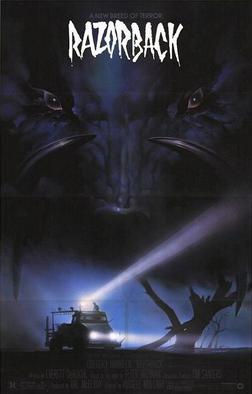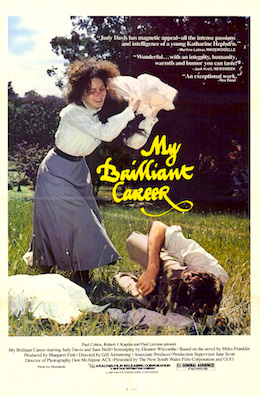
Until the End of the World is a 1991 epic science fiction adventure drama film directed by Wim Wenders. Set at the turn of the millennium in the shadow of a world-changing catastrophe, the film follows a man and woman, played by William Hurt and Solveig Dommartin, as they are pursued across the globe, in a plot involving a device that can record visual experiences and visualize dreams. An initial draft of the screenplay was written by American filmmaker Michael Almereyda, but the final screenplay is credited to Wenders and Peter Carey, from a story by Wenders and Dommartin. Wenders, whose career had been distinguished by his exploration of the road movie, intended this as the ultimate example of the genre.

Peter Lindsay Weir is an Australian retired film director. He is known for directing films crossing various genres over forty years with films such as Picnic at Hanging Rock (1975), Gallipoli (1981), The Year of Living Dangerously (1982), Witness (1985), Dead Poets Society (1989), Fearless (1993), The Truman Show (1998), Master and Commander: The Far Side of the World (2003), and The Way Back (2010). He has received six Academy Award nominations, ultimately being awarded the Academy Honorary Award in 2022 for his lifetime achievement career.

Dreams is a 1990 magical realist anthology film of eight vignettes written and directed by Akira Kurosawa, starring Akira Terao, Martin Scorsese, Chishū Ryū, Mieko Harada and Mitsuko Baisho. It was inspired by actual recurring dreams that Kurosawa said he had repeatedly. It was his first film in 45 years in which he was the sole author of the screenplay. An international co-production of Japan and the United States, Dreams was made five years after Ran, with assistance from George Lucas and Steven Spielberg, and funded by Warner Bros. The film was screened out of competition at the 1990 Cannes Film Festival, and has consistently received positive reviews.

Videodrome is a 1983 Canadian science fiction body horror film written and directed by David Cronenberg and starring James Woods, Sonja Smits, and Debbie Harry. Set in Toronto during the early 1980s, it follows the CEO of a small UHF television station who stumbles upon a broadcast signal of snuff films. Layers of deception and mind-control conspiracy unfold as he attempts to uncover the signal's source, complicated by increasingly intense hallucinations that cause him to lose his grasp on reality.

Walkabout is a 1971 adventure survival film directed by Nicolas Roeg and starring Jenny Agutter, Luc Roeg, and David Gulpilil. Edward Bond wrote the screenplay, which is loosely based on the 1959 novel by James Vance Marshall. It centres on two white schoolchildren who are left to fend for themselves in the Australian Outback and who come across a teenage Aboriginal boy who helps them to survive.

Breaking The Waves is a 1996 psychological romantic melodrama film directed and co-written by Lars von Trier and starring Emily Watson in her feature film acting debut, and with Stellan Skarsgård, a frequent collaborator with von Trier.

David Dhalatnghu Gulpilil was an Australian actor and dancer. He was known for his roles in the films Walkabout (1971), Storm Boy (1976), The Last Wave (1977), Crocodile Dundee (1986), Rabbit-Proof Fence, The Tracker and Australia (2008).

Pierrot le Fou is a 1965 French New Wave romantic crime drama road film written and directed by Jean-Luc Godard, starring Jean-Paul Belmondo and Anna Karina. The film is based on the 1962 novel Obsession by Lionel White. It was Godard's tenth feature film, released between Alphaville and Masculin, féminin. The plot follows Ferdinand, an unhappily married man, as he escapes his boring society and travels from Paris to the Mediterranean Sea with Marianne, a girl chased by OAS hitmen from Algeria.

The Cars That Ate Paris is a 1974 Australian horror comedy film, produced by twin brothers Hal and Jim McElroy and directed by Peter Weir. It was his first feature film, and was also based on an original story he had written. Shot mostly in the rural town of Sofala, New South Wales, the film is set in the fictional town of Paris in which most of the inhabitants appear to be directly, or indirectly, involved in profiting from the results of car accidents. The film is considered part of the Australian New Wave genre.

The Proposition is a 2005 Australian Western film directed by John Hillcoat and written by screenwriter and musician Nick Cave. It stars Guy Pearce, Ray Winstone, Emily Watson, John Hurt, Danny Huston and David Wenham. The film's production completed in 2004 and was followed by a wide 2005 release in Australia and a 2006 cinematic run in the U.S. through First Look Pictures. The film was shot on location in Winton, Queensland.

Razorback is a 1984 Australian natural horror film written by Everett De Roche, based on Peter Brennan's 1981 novel, and directed by Russell Mulcahy. The film revolves around the attacks of a gigantic wild boar terrorising the Australian outback, killing and devouring people. It was released theatrically in Australia by Greater Union Film Distributors on 19 April 1984, and in the United States by Warner Bros. on 16 November 1984.

Anindilyakwa is an Australian Aboriginal language spoken by the Anindilyakwa people on Groote Eylandt and Bickerton Island in the Gulf of Carpentaria in the Northern Territory of Australia. Anindilyakwa is a multiple-classifying prefixing language in which all traditional nouns, adjectives, personal and demonstrative pronouns are prefixed for person, number and gender. According to the 2021 Australian Census, Anindilyakwa was spoken natively by 1,516 people, an increase from 1,283 in 2006.

Picnic at Hanging Rock is a 1975 Australian mystery film directed by Peter Weir and based on the 1967 novel Picnic at Hanging Rock by Joan Lindsay. Cliff Green adapted the novel into a screenplay. The film stars Rachel Roberts, Dominic Guard, Helen Morse, Vivean Gray and Jacki Weaver. The plot involves the disappearance of several schoolgirls and their teacher during a picnic at Hanging Rock, Victoria on Valentine's Day in 1900, and the subsequent effect on the local community.

The Right-Hand Man is a young adult historical novel by K. M. Peyton, first published in 1977. The book is set in 1818 in Essex and London, during the Georgian era. It tells the story of Ned Rowlands, a talented stagecoach driver who meets the three creatures he loves best on the same day: a horse, a woman, and the man who will become his employer, Lord Ironminster.

Throw Down is a 2004 Hong Kong martial arts film directed by Johnnie To and starring Louis Koo, Aaron Kwok, Cherrie Ying, and Tony Leung Ka-fai. To dedicated the film to the late Japanese filmmaker Akira Kurosawa and, in making it, had drawn upon elements of Kurosawa's debut feature, Sanshiro Sugata. Throw Down had its premiere at the 61st Venice International Film Festival.

My Brilliant Career is a 1979 Australian period drama film directed by Gillian Armstrong, and starring Judy Davis, Sam Neill, and Wendy Hughes. Based on the 1901 novel of the same name by Miles Franklin, it follows a young woman in rural, late-19th-century Australia whose aspirations to become a writer are impeded first by her social circumstance, and later by a budding romance.

Jubal is a 1956 American Western film directed by Delmer Daves and starring Glenn Ford, Ernest Borgnine, Rod Steiger, Valerie French, and Felicia Farr. Shot in CinemaScope, it was one of the few adult westerns in the 1950s and is described as Othello on the Range. The supporting cast features Noah Beery Jr., Charles Bronson and Jack Elam.

The Chant of Jimmie Blacksmith is a 1978 Australian drama film directed, written and produced by Fred Schepisi, and starring Tom E. Lewis, Freddy Reynolds and Ray Barrett. The film also featured early appearances by Bryan Brown, Arthur Dignam, and John Jarratt. It is an adaptation of the 1972 novel The Chant of Jimmie Blacksmith by Thomas Keneally.

Inn of the Damned is a 1975 Australian western horror film, directed by Terry Bourke. It has been called Australia's first "horror Western".

The Anindilyakwa people (Warnumamalya) are Aboriginal Australian people living on Groote Eylandt, Bickerton Island, and Woodah Island in the Gulf of Carpentaria in the Northern Territory of Australia.




















